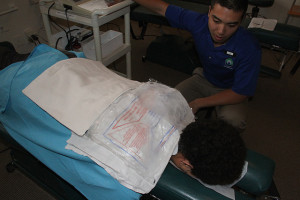 Ice and Heat
Ice and Heat
The effects of ice on a body part reduce circulation, provide an analgesic effect, and slow the collection of edema in an acute injury. A combination of ice, compression, and elevation should exclusively be used within the first three days of an injury’s onset. This provides vasoconstriction, pain relief for damaged nerve endings, and a reduced inflammatory response. The effects of ice are much longer-lasting and penetrate the skin deeper than the effects of heat. Ice should also be used continuously during the treatment and rehabilitation process to prevent future flare-ups, and decrease the micro trauma done to the tissues by strenuous exercise or deep massage/stretch work.
Physiologically, heat works using the opposite effects of ice. Heating up the skin and underlying tissue causes a vasodilation, and increased circulation to the immediate area. Heat should be used after the first phase of the inflammatory response cycle has passed. Its thermal effects are good for warming the superficial skin and muscle tissue before performing any rehabilitation work such as massage, stretch, or exercise. This protects the muscle fibers from over-stretching and possibly tearing when they are cold. Heat can have an analgesic effect, but these benefits are more temporary than with ice. This is because the blood neutralizes a warm temperature faster than it can a cooler one. Lastly, heat is good in chronic conditions where scar tissue, adhesions, and myofascial restrictions are present because it serves to soften these tissues to allow the therapist or doctor to work deeper and initiate a more intense stretch.
